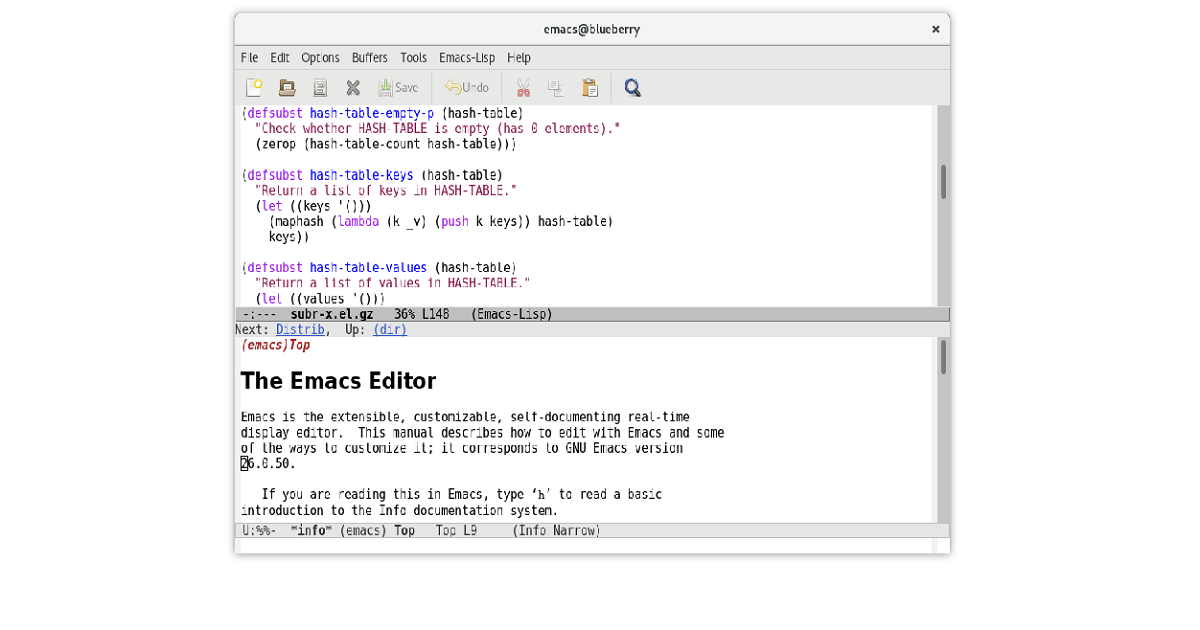
The new version has just been announced from the popular text editor GNU Emacs 27.1 which has recently been based on the GNU Multiple Precision Library (GMP) and arrives with some news quite interesting such cLike HarfBuzz support for native JSON parsing and text formatting.
For those who are unfamiliar with this popular text editor, they should know that GNU Emacs is an extensible, customizable, free and open text editor created by the founder of the GNU Project, Richard Stallman. This is the most popular of the Emacs family of text editors.
This text editor is available for GNU / Linux, Windows and macOS, It is written in C and provides Emacs Lisp as an extension language. Also implemented in C, Emacs Lisp is a "dialect" of the Lisp programming language used by Emacs as a scripting language.
For those who are not familiar with this text editor, GNU Emacs features include:
- content-sensitive editing modes, including syntax highlighting, for many file types
- Integrated comprehensive documentation, including a tutorial for new users
- Full Unicode support for almost all scripts
- It is also highly customizable, using Emacs Lisp code or a graphical user interface.
- It has a full ecosystem of features beyond just text editing, including your schedule tracking and project planner (with Org mode), an email and newsreader (Gnus), a debugging interface, and more.
- And many more
Main new features of GNU Emacs 27.1
In this new version of GNU Emacs 27.1 it is possible to be able to manage the two texts in the editor content through tabs either using mode “Tab-Line” or “Tab-Bar mode”. The first option is similar to the way browsers display content. Each buffer has its own tab and clicking on one of the tabs activates the corresponding content.
Along with it new commands are added to enable the tab bar at the top of each frame and the tab lines above the windows, so developers can switch between persistent window settings and buffers in the window respectively.
The mode can be activated with the command Global-Tab-Line-Mode. The combination Ctrl + X + LEFT or the previous-buffer command goes to the previous buffer and the next-buffer command or the combination Ctrl + X + RIGHT to the next buffer.
Another novelty is the new option –Whit-cairo to build the editor with support for the tool drawing from its experimental state, as well as the implementation of the new version is based on the Jansson library for native JSON content parsing.
On the other hand too it is noted that it is now possible to use the HarfBuzz library to format text.
In addition, it is also mentioned that this new version of emacs is replacing Imagemagick, which was previously used as a standard for displaying graphics. The editor also dispenses with the graphics package to scale and rotate graphics. According to the Emacs team, the background is the security and stability issues with ImageMagick.
Finally, if you want to know more about this new version of the editor, you can check the details in the official announcement In the following link.
How to install Gnu Emacs on Ubuntu and derivatives?
If you are interested in being able to install this new version of Gnu Emacs on your distro, They can do it in two ways.
The first one of them is to do it directly from the Software Center from Ubuntu or with the help of Synaptic.
Although, as you know, application updates are not usually available immediately, so we must wait a few days for it to be made available to everyone.
The other way and the recommended in order to have ya a more current version is by downloading and compiling the source code that can be found on the publisher's official website.
Good article! I would add that it is also compatible with BSD systems. All the best